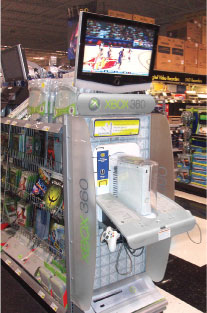Designing Globally, Winning Shoppers Locally

- Even as the store wars between the video game manufacturers continued to heat up going into the 2006 Christmas season (with the late launch of the Sony PS3 in November), one contender grabbed top honors in two of the in-store display industry's most prestigious competitions. The Microsoft Xbox 360 kiosk program, produced by Design Phase, Inc. of Waukegan, Illinois, was the winner of a Gold Award for best permanent display in the Electronic Interactive and Technology category in POPAI's 2006 Outstanding Merchandising Achievement (OMA) competition, with winners announced at Globalshop. The Xbox 360 Kiosk Program also earned the Best of the Times award, the highest award in the annual Design of the Times Awards competition, produced by The In- Store Marketing Institute, with 2006 winners announced in late September.
An Xbox 360 kiosk as an end-cap in a Best Buy store.
Design Phase was no stranger to creating interactive displays when they were tapped by Microsoft for the Xbox 360 campaign. Prior to working with Microsoft, Design Phase designed interactive kiosks for brands like Disney, Vtech, Leapfrog, Nintendo, and the Starlight Foundation.
"When designing interactive displays," Mike Eckert, President of Design Phase tells Marketing At Retail, "there are three important challenges: controller mount durability; overall kiosk durability; and modularity. Over the last 15 years we've come a long way in developing controller arms that are flexible enough for game play and durable enough to last for years. These interactives have to be built for extreme abuse in the retail environment.

Located inside the back arc are two hidden curved metal tubes used for strengthening the length and weight of the kiosk. In between these tubes are all the light and power supply sources (wiring, plugs, and plug strips).
The Xbox 360 kiosk program was one of the most dominant marketing elements in the launch of the Microsoft's Xbox 360. It is more than a display, it is a hands-on, interactive game machine, designed to demo the product in an elegant package while taking untold abuse in-store. And it is the at-retail anchor to a truly international product launch.
For this high-stakes product launch, Microsoft called on Design Phase to achieve the near-impossible: To create a modular system of interactive displays with elements suitable for retail implementation in North America, Latin America, Europe, Australia, Asia, and Japan. To facilitate a worldwide launch with Xbox 360 brand consistency throughout. To design a kiosk program that attracts a broader audience, while not alienating the core audience. To offer interactivity, product trial, and product information to influence point of sale purchase decisions with the attention paid to leveraging efficiencies gained from Xbox kiosks. To drive sales through trial. To promote games, accessories, and console (beyond the typical video game interactive kiosk, these kiosks offer downloadable consumer content for personalizing their gaming experience and personalized audio jacks for an enhanced retail demonstration experience).
Each kiosk system emulates the shape of the Xbox game console from the actual body structure to the console cover. The console cover was made out of clear polycarbonate for its durability and visibility of the console itself. LED lights were used over other options for their low voltage, changeout, and longevity. The color choices made are consistent with the brand image, having clean defined edges and sophisticated surfaces. Each decision that was made regarding the look and feel of the display had to be suitable for its worldwide audience. There were different options for the kiosk that accommodated these varying requirements.
For example, the kiosks were available as a floor or shelf unit. The floor unit was either 80 inches or 74 inches tall. The European and Asian markets had unique height requirements, so simple adjustment to the top of the kiosk allowed either a vertical or horizontal header system. The shelf unit was made as one size with different hanging bracket options dependent on the various gondola systems around the world. With the varying heights at store level, there were three options for the monitor size, 17 inches, 19 inches, or 23 inches. Both the shelf and the floor unit came with the option of LED lights (on the sides, headers, and or console) or wheels. Many countries move kiosks pending space availability or special events. For example, in Japan, kiosks are moved outside to drive consumers in. The total size had to be narrow in width to work for European, Asian, and Australian, markets and to fulfill brand requirements. "Creatively, certainly the big challenge was getting a global approval on one design of the kiosk from Microsoft," says Bryan Lump, Senior Designer at Design Phase. "And to achieve all brand level goals and to be brand consistent worldwide." The structure of Xbox 360 kiosk, with its curved lines, needed durability and strength while keeping consistent with the look and feel of the brand and kiosk design. The materials used were ABS, polycarbonate, metal, and cast aluminum. Design Phase used injected molded plastic for the front and back arc of the kiosk and added ribs to the underside of each component for strength and durability. Located inside the back arc are two hidden curved metal tubes used for strengthening the length and weight of the kiosk. In between these tubes are all the light and power supply sources (wiring, plugs, and plug strips). This area is concealed by two curved wiring covers that were designed with the brand in mind; the panels were designed in two pieces for ease of service/repair entry.
The base is made of cast aluminum for durability and strength. The kiosk has LED lights used to highlight and bring attention to the kiosk without shouting at the consumer. The LEDs were sourced for their dependability, longevity, and to reduce long-term maintenance costs. They were used in three areas — on each side of the kiosk (between the white and Xbox green acrylic panels for a glow affect), on the header, and under the console.
A daily selection of features, industry news, and analysis for AV/IT professionals. Sign up below.
The power and wiring of each kiosk is globally accepted (for Europe, Asia, Latin America, U.S., and Australia). There is an international five-plug power strip located inside the kiosk that helped globally address the many different needs of each country's power requirements. This allowed Design Phase to use standard approved power plugs for the monitor, medusa, console, and LEDs (plugs into the power strip), and also use a more country- specific exit power cord. All engineered parts, including hardware, were done in metric for global procurement. Building and delivering over 16,000 kiosks worldwide, simultaneously, created more than design challenges.
Parts and sub assemblies were shipped to three different regions, China, the U.S., and Yorkshire England, for assembly. Shipping by boat and air was used in a variety of configurations. "A typhoon at sea slowed down our ships and Hurricane Katrina shut down many southern ports, which overwhelmed ports all over the country,"
says Mary Beth Hicks, VP of Sales at Design Phase. "These delays made it clear we would have to increase our assembly line outputs to meet the Xbox 360 launch date. At our peak we produced over 500 interactives a day worldwide."
What about the shopping experience? The Xbox 360 kiosk display calls out to the consumer. There is a demo disc placed into the game console that will run a loop of information on a HD monitor (LCD panels sourced from Samsung), highlighting the game console and its many accessories, as well as allowing consumers to sample different games. This catches consumers' attention graphically and verbally. Once the consumer is engaged with the unit and pushes a button on the controller, the menu screen appears, allowing the customer to learn more about the Xbox 360. The display also features a Memory Unit (MU) port. The MU Port has downloadable content only available on the kiosk, which brings traffic to the kiosk. A consumer with a MU card can plug their own personal card into the kiosk to download special content that consumers can use at home on their personal Xbox 360 console. They have the ability to download characters, maps, game video clips, and music.
It's not easy to design a kiosk program that attracts a broader audience while not alienating the core video game audience. "There is a fine line when designing for both hardcore gamers versus casual gamers," comments Mike Eckert. "The use of a 23- inch Samsung HD LCD monitor attracted both audiences and showcased Xbox 360's incredible graphic capabilities. The kiosk color scheme and design were true to the brand, appealing to both audiences."
Graphically, the display has two areas on the deck lid that are utilized for educating the consumer on the many features and benefits of the console.
In addition, these changeable graphics have a clear cover over them for security. The front arc panel also allows for a graphic.
As visually appealing, as interactive, and as rugged the kiosk is, the proof of success is, of course, at-retail. The kiosk video game trial and peripheral product information contributed to the historically highest product attach ratio of any video game system in its first month of sales. And analysts are predicting that Microsoft's effort to win market share could garner Xbox 360 up to 40 percent market share as early as the coming year. If this happens, it won't all come from in-store, but with campaigns like this one, that road will certainly be easier.
